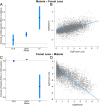Amazon deforestation drives malaria transmission, and malaria burden reduces forest clearing
- PMID: 31611369
- PMCID: PMC6825316
- DOI: 10.1073/pnas.1905315116
Amazon deforestation drives malaria transmission, and malaria burden reduces forest clearing
Erratum in
-
Correction for MacDonald and Mordecai, Amazon deforestation drives malaria transmission, and malaria burden reduces forest clearing.Proc Natl Acad Sci U S A. 2020 Aug 18;117(33):20335. doi: 10.1073/pnas.2014828117. Epub 2020 Aug 10. Proc Natl Acad Sci U S A. 2020. PMID: 32778593 Free PMC article. No abstract available.
Abstract
Deforestation and land use change are among the most pressing anthropogenic environmental impacts. In Brazil, a resurgence of malaria in recent decades paralleled rapid deforestation and settlement in the Amazon basin, yet evidence of a deforestation-driven increase in malaria remains equivocal. We hypothesize an underlying cause of this ambiguity is that deforestation and malaria influence each other in bidirectional causal relationships-deforestation increases malaria through ecological mechanisms and malaria reduces deforestation through socioeconomic mechanisms-and that the strength of these relationships depends on the stage of land use transformation. We test these hypotheses with a large geospatial dataset encompassing 795 municipalities across 13 y (2003 to 2015) and show deforestation has a strong positive effect on malaria incidence. Our results suggest a 10% increase in deforestation leads to a 3.3% increase in malaria incidence (∼9,980 additional cases associated with 1,567 additional km2 lost in 2008, the study midpoint, Amazon-wide). The effect is larger in the interior and absent in outer Amazonian states where little forest remains. However, this strong effect is only detectable after controlling for a feedback of malaria burden on forest loss, whereby increased malaria burden significantly reduces forest clearing, possibly mediated by human behavior or economic development. We estimate a 1% increase in malaria incidence results in a 1.4% decrease in forest area cleared (∼219 fewer km2 cleared associated with 3,024 additional cases in 2008). This bidirectional socioecological feedback between deforestation and malaria, which attenuates as land use intensifies, illustrates the intimate ties between environmental change and human health.
Keywords: Brazil; Plasmodium falciparum; Plasmodium vivax; environmental change; instrumental variables.
Conflict of interest statement
The authors declare no competing interest.
Figures


Comment in
-
Response to Valle and Zorello Laporta: Clarifying the Use of Instrumental Variable Methods to Understand the Effects of Environmental Change on Infectious Disease Transmission.Am J Trop Med Hyg. 2021 Sep 27;105(6):1456-1459. doi: 10.4269/ajtmh.21-0218. Am J Trop Med Hyg. 2021. PMID: 34583331 Free PMC article.
References
-
- Foley J. A., et al. , Global consequences of land use. Science 309, 570–574 (2005). - PubMed
-
- MacDonald A. J., Larsen A. E., Plantinga A. J., Missing the people for the trees: Identifying coupled natural-human system feedbacks driving the ecology of Lyme disease. J. Appl. Ecol. 56, 354–364 (2019).

